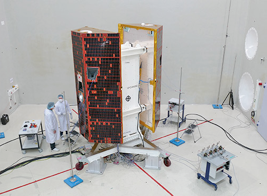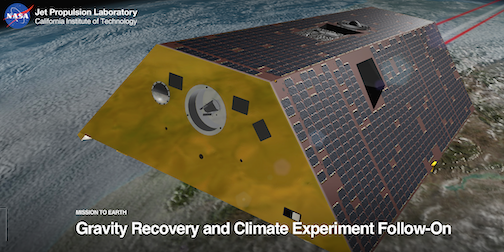
Preparations for the acoustic noise test for the two GRACE-FO satellites, which Airbus constructed for NASA/JPL. Photo: Airbus DS GmbH / Mathias Pikelj
They got out the ear plugs during some serious acoustic testing that recently took place as the two GRACE-FO (GRACE = Gravity Recovery and Climate Experiment, FO = Follow-On) Earth observation satellites, which Airbus Friedrichshafen developed and constructed for NASA/JPL, were ‘given an earful’ during recent acoustic tests.
The sound impact that builds up during rocket launches was simulated in an echo chamber with a volume of around 1,400 m³ at IABG in Ottobrunn near Munich. In four test cycles, the satellites in their flight position were subjected to a sound impact of nearly 140 decibels (dB). In comparison, a pneumatic drill produces 100 dB and the human pain threshold is 130 dB. Both satellites passed the tests with flying colors.

NASA’s Jet Propulsion Laboratory JPL (Pasadena, California) in partnership with the German Research Center for Geosciences (GFZ, Potsdam) will send both GRACE-FO research satellites into a polar orbit at an altitude of around 500 km and at a distance of 220 km apart. This is a follow-on to the GRACE mission, which has been successfully operating since 2002. Both satellites will continually take very exact measurements of their separation distance, which changes depending on the Earth’s gravity. In this way, scientists are able to map the Earth’s gravitational fields.
A global positioning system and a microwave ranging system enable the distance between the satellites to be measured to within one micron. The GRACE-FO satellites will feature an additional element: a new inter-satellite laser ranging instrument, developed by a German/American joint venture, which will be tested for use in future generations of gravitational research satellites. Orbital perturbations through non-gravitational effects such as aerodynamic braking due to the residual atmosphere are determined with the help of a sensitive accelerometer.
The launch of the GRACE-FO twin satellites is scheduled between December 2017 and February 2018. Over the course of the five-year mission, measurements will be taken to provide an updated model of the Earth’s gravitational fields every 30 days. In addition, each of the satellites will supply up to 200 profiles of temperature distribution and water-vapour content in the atmosphere and the ionosphere on a daily basis.

